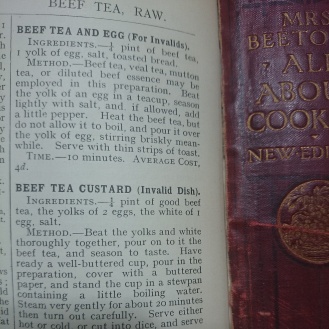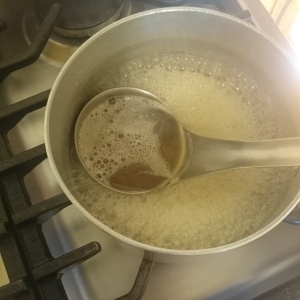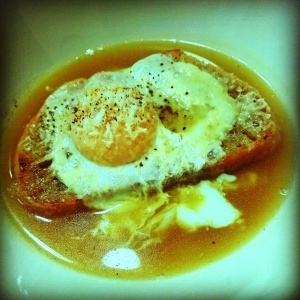The cold weather of recent days has had me thinking about soup. Always a great warming stand by, offering some of the most diverse dishes available, limited really only by ones imagination. Of course traditionally in addition to providing warming nourishment, these “wet” foods would have provided much of ones daily liquid intake, and I clearly remember as a young chef being told by my first mentor, a chef of Indian extraction that we didn’t “eat” enough liquid in the west and to be honest he was right.
Our western diet today tends to be over processed and “dry” with moisture ironically provided by bottled water or other beverages. By comparison Southern India has broth in the form of thin clear rasam at the centre of its cuisine. Take “Milagu Thanni” or pepper water for example, unfortunately we probably know it as the anglicized Mulligatawny, a heavy, creamy curried chicken soup thickened with rice and garnished with apple, but this is a far cry from the original almost clear, spicy, tomato, tamarind and curry leaf broth that aids digestion and helps with hydration.
Of course right now because of the Paleo fad and the fuss that has surrounded the bone broth craze, there is renewed interest in nutritious stocks and consommés. But nutritious broths are nothing new, every carnivorous culture knows and has valued the restorative power of soup (this is supposedly how the term Restaurant was first coined, but that’s a story for another day). In Victorian Britain, Eliza Beeton recommended Beef Tea for invalids, the famous Chicken Soup of Eastern European/Ashkenazic tradition and so beloved in my Barossa homeland (albeit with noodles instead of matzo balls) is often referred to as Jewish Penicillin and the Vietnamese pay great attention to the health and strength given properties of a long simmered Pho.
More to the point our modern English word soup comes from the old English “Sop” to soak bread in liquid, which in turn is related to “Sup” meaning to swallow and certainly soaking stale country bread in hot broth made these early soups thicker and more filling. Continuing on this theme, some of the worlds best known national dishes are really soups or soupy stews, for example: Bouillabaise, Minestra, Gulyas, Borscht, Cock a leekie, Waterzoi, Chowder and the list goes on, but the thing these all have in common is that they were originally simple peasant foods, basic dishes that formed the basis of most meals.
Today’s blog is about one such soup, one definitely not as well known as any of the soups mentioned above, but absolutely and fundamentally peasant in origin. I am talking of the Italian classic Zuppa Pavese. Hailing from Pavia, near Milan in Northern Italy. Romantic legend has it that it was created in the early 1500’s by a peasant farmer for the then King Francis I of France who was fleeing a defeat in the battle of Pavia, though this is highly unlikely seeing as he was captured on the battlefield, nice story though…
As far as my history with this soup is concerned, I first came across it as a young chef dining at a tiny, rustic, Italian restaurant in Adelaide in the 1970’s, the type with gingham table cloths and ruffina flasks as candle sticks. I recall it was both cheap and the special of the day and completely unknown to me, but to my surprise it was a revelation remaining a personal favourite to this day.
Simply put it is perfect for lunch or a light “Supper” being very quick and easy. To prepare it, take a good slice of crusty country style bread, fry it in butter until crisp and golden on both sides, place in a heated bowl, break a couple of very fresh eggs on top, sprinkle with Parmesan cheese and pour well flavoured, boiling broth over to just set the eggs and serve immediately…. nothing too it really!.
Sure it’s not modernist cuisine, though I am sure someone out there will have by now put together a ludicrous deconstructed version with a “40 minute sous vide egg, buttered sour dough gravel, parmesan foam and gelatin filtered consommé” . Of course in its own way that idea ’s not very different from Escoffier listing a recipe for “Mille –Fanti” in his Guide Culinaire. This was an Italian inspired egg drop soup made with strong consommé, eggs, bread and parmesan, precisely the same ingredients as Zuppa Pavese and one can only wonder if the Thousand Footmen of the name is another reference to Francis’s and his army.
No, for me Zuppa Pavese is a perfect example of a simple peasant dish that to succeed only needs great ingredients and absolutely no embellishment. Now my poor old dad would have never come at this, the thought of what he would call a “snotty egg” being just too much, and another very good chef friend of mine will probably be equally repulsed at the thought of a “soppy, soggy croute”. But this soup is a restorative in every possible way. The protein of the egg, gelatinous broth and umami rich cheese combining with the butter fried bread to make a simple and honest, healthy and hearty meal, seriously can good food be any easier?
Buon Appetito
Zuppa Pavese – per person
200ml chicken stock- well seasoned– recipe following
2 teaspoons butter
1 slice day old crusty bread
1 or 2 eggs – very fresh & at room temperature
2 tablespoons Parmesan cheese – grated
Method
- Warm bowl(s) with boiling water and place eggs in bowl to warm slightly
- Bring stock to a simmer and ensure it is well seasoned
- Pan fry bread until golden on both sides, drain water from serving dish
- Place fried bread in the base of bowl, crack egg(s)onto bread and sprinkle with half the parmesan
- Ladle boiling stock into bowl and over egg – stock must be boiling rapidly
- Cover bowl with a lid or plate for 30 seconds, remove, add remaining parmesan and serve
Chicken stock
1kg chicken bones
1kg chicken wings
1 carrot
1 stick celery
2 onions
1 bay leaf
6 peppercorns
20g parsley stalks
1.7 litres water
Sprig thyme
Method
- Rinse bones and wings well, place in a pressure cooker with all other ingredients
- Close and seal vessel, bring to pressure and cook following safety instructions for 20 minutes.
- After cooking time is complete, follow your appliances safety procedures to reduce pressure and only open when fully depressurised.
- Strain through a fine filter, allow to settle for 10 minutes and remove as much fat as possible from the surface and reserve for later use.
Note: if not using pressure cooker, use recipe but increase water to 3.5 litres, bring to a simmer uncovered and cook very gently for 3 hours, strain and reduce by boiling to 1200ml








